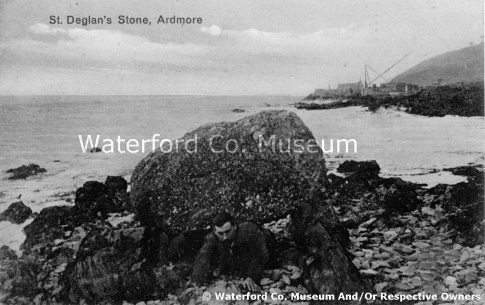24th July - St. Declan of Ardmore
Written by Anne Newman - 17th July 2019
Declan came from the royal house of the Déisí and probably studied in Wales or in Gaul. According to the Life he visited Rome.
Declan is special, marked out for a higher purpose. Even before his birth, events in the night sky herald his arrival to those with a mind for such things. His coming into the world is easy - his mother, Deithín, knows neither sickness nor pain. She and Declan's father, Erc MacTréin, are in west Co. Waterford, between Lismore and Cappoquin, visiting Dobhrán, their relation.
Declan receives baptism from Colmán, a holy man who can sense peope talents. In the baby Declan, he senses a sanctity and advises that Declan should receive a Christian education once he is old enough.
Declan in Rome
After being fostered by
Dobhrán, Declan then studies with Díoma, a local holy man. Declan,
takes to learning and spends many a night hunched over the scriptures by
candle light.
His appetite for learning takes him to Rome, where he learns the intricacies of the ecclesiastical system. Declan is well received in Rome. Fellow Irishman, Bishop Ailbe, recommends him to those on high, citing his noble lineage and holiness. Thus begins a friendship between Ailbe and Declan, and during his time in Rome, Declan ascends to the same office as his mentor. After a while Declan is sent home to Ireland by Pope Hilary, charged with a mission to preach.
On the long road back through Italy, Declan, meets Patrick, who is on his way to Rome. In time, they shall meet again, on Irish soil.
Back in Ireland
Declan resumes his close friendship with Ailbe, and proceeds to throw himself into his assignment, aided by disciples gathered in Rome. In the resultant flurry of activity, churches are established, sermons preached and people baptised. Declan's irrepressible energy and enthusiasm radiate throughout the west Waterford region, or the Déise, as it is known. The promise of his early years is beginning to be realised.
Declan shows himself to
be a magnetic figure, bringing in funding to get a monastery built
and inspires others to join the religious life.
Declan's monastery at
Ardmore is founded after a further visit to Rome.
Sailing back via Wales, Declan determines to establish his monastic city wherever his craft lands, and it is to Ardmore that destiny takes him. The king of the Déisí - the resident tribe in west Waterford and east Cork - generously donates the land to Bishop Declan's cause.
Ardmore's fame spreads
beyond the boundaries of the Déise. People come from far and wide
around Ireland, to be part of this venture. Declan, with his
gentleness and charity, enjoys great popularity.
Many of his
followers prefer to be under his immediate sway at Ardmore, than in
authority by his leave elsewhere! Declan travels the Déise territory
preaching.
Cashel, the seat of royal power in Munster, is frequently honoured by Declan's visits. Once, in a time of the plague, the Declan miraculously cures seven noblemen struck down by the deadly scourge, much to the gratitude of the king, and the wonder of his subjects. The people of Cashel gave glory to God, and Declan's fame spread throughout the land.
Humble Ailbe, the Patrick of Munster, greater than any saying,
Declan, Patrick of the Déisí - the Déise to Declan for ever?
Ardmore
- Oratory
near the Cathedral and Round Tower in the graveyard.
- Stone on the beach.
A
glacial boulder of very hard conglomerate which lies on a rocky ledge
of beach beneath the village of Ardmore.
It measures some 8' 6" x 4' 6" x 4' 0" and sits on two slightly jutting points of the underlying rock. it is the only stone of its kind on the beach.
|
Saint Declan's Stone, Ardmore. A man crawling underneath Saint Declan's Stone, Ardmore. In the background is Ardmore Pier under construction. No: UK376 Photographer: Unknown Date: Circa 1910
|
 |
||||
Pilgims crawl on face and hands through the narrow space between the boulder and the underlying rock on his patron day to receive healing and blessings. It is believed to be good for treating back pain and rheumatism.
It was also circled a number of times on the knees while
praying.
The story of the stone is:
When the saint was returning from Wales, he realised he had left his bell behind on a rock on the foreshore. He prayed to God and the stone started to float after him with the bell on top of it. Recognising the miracle he allowed the boulder to lead the way and decided that wherever it was to land he would set up his church. This of course landed on the beach of Ardmore where it still remains today, only accessible at low tide.
- Well on the cliff
St. Declan's Well, is beside remains of a rather large and apparently 12th century church on the cliff, in the townland of Dysert.
It is diverted into a shallow basin in which pilgrims bathe feet and hands. Individuals come to the well, drink the water, do the rounds while reciting the rosary. Cures for skin diseases, ringworm especially, is attributed to it.
- Stone said to have been found in his tomb and preserved at Ardmore.
The second 'St.
Declan's Stone' was a small, cross-inscribed jet black piece of slate
or marble.
Formerly
it seems to have had a small silver cross inset and was in great
demand locally as an amulet for cattle curing. It disappeared.
- Pastoral staff and bell
There are also tales of these belonging to the saint but have disappeared for centuries.
--- oOo ---
Anne is sharing a series of events throughout the year - you can find them listed by clicking to the link Other Notable Dates and Festivals.





